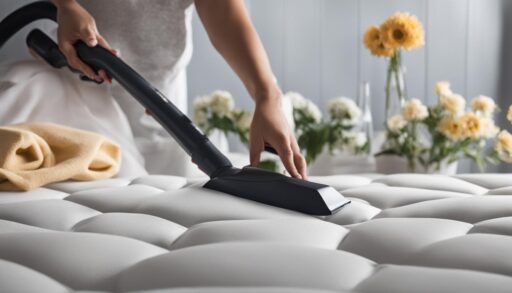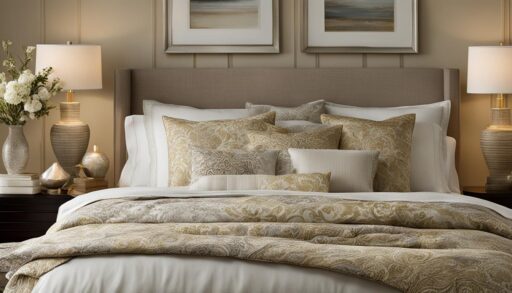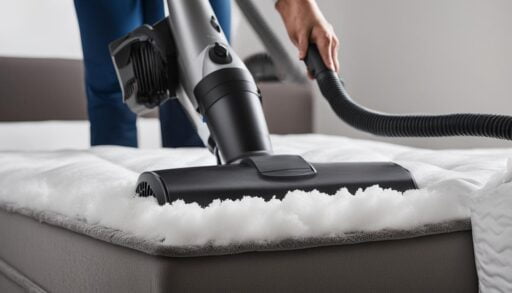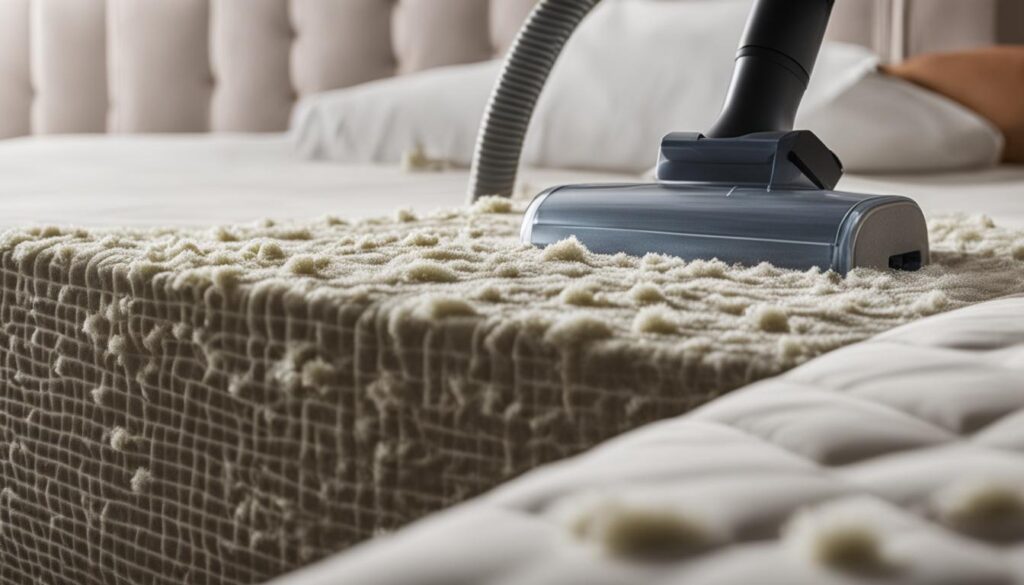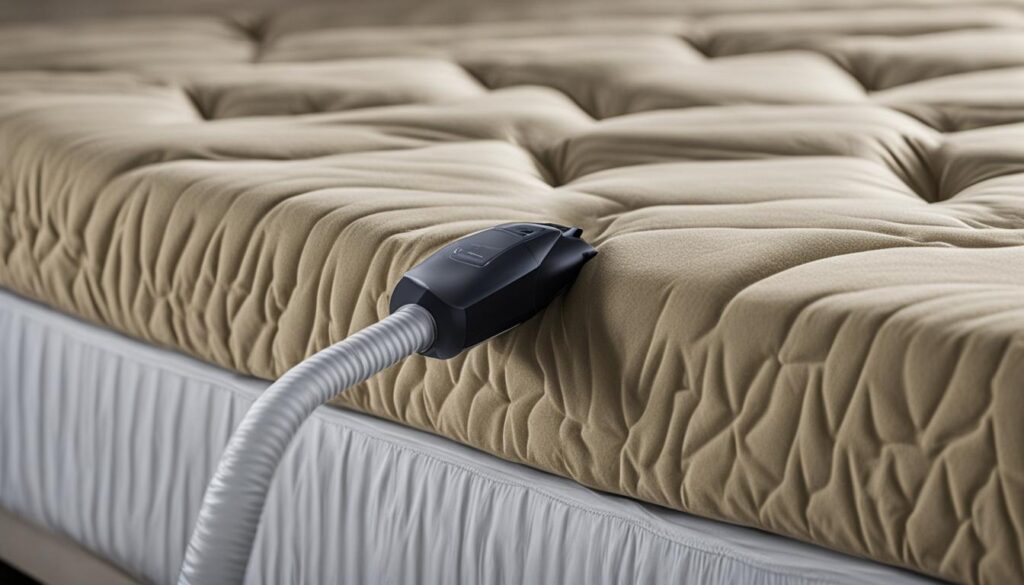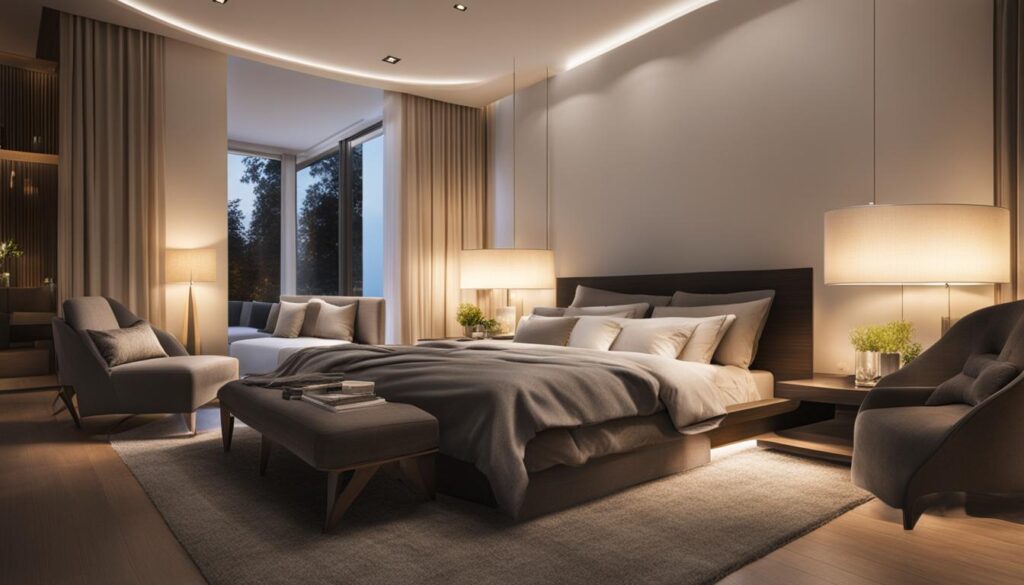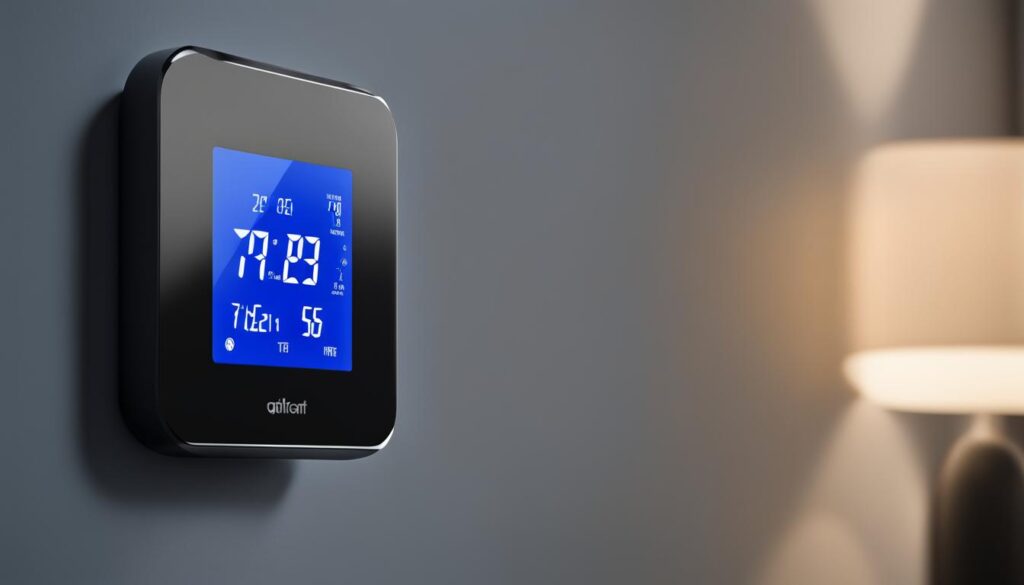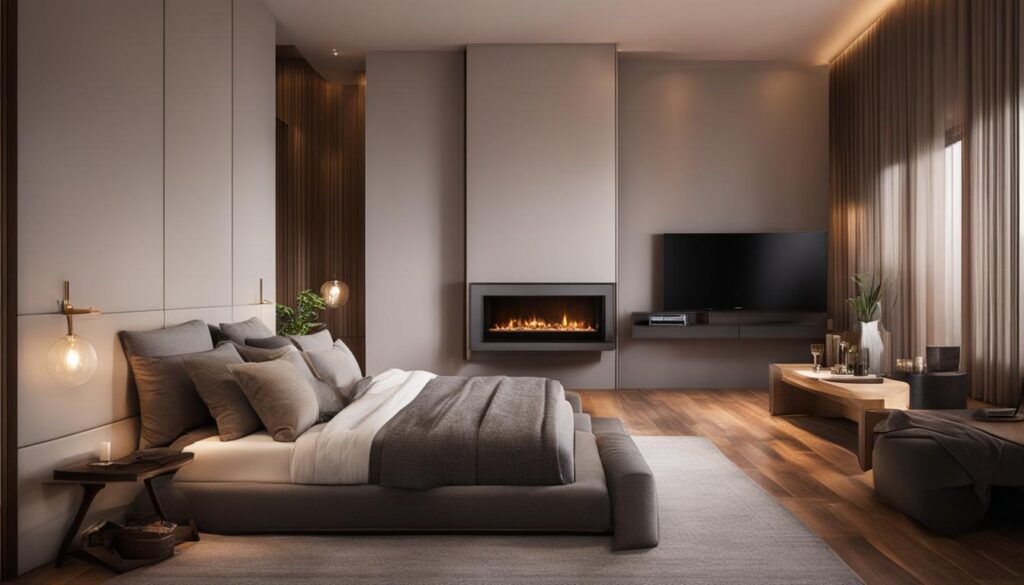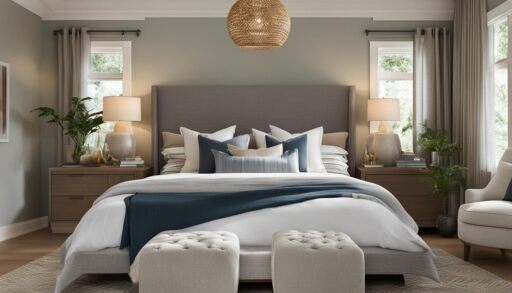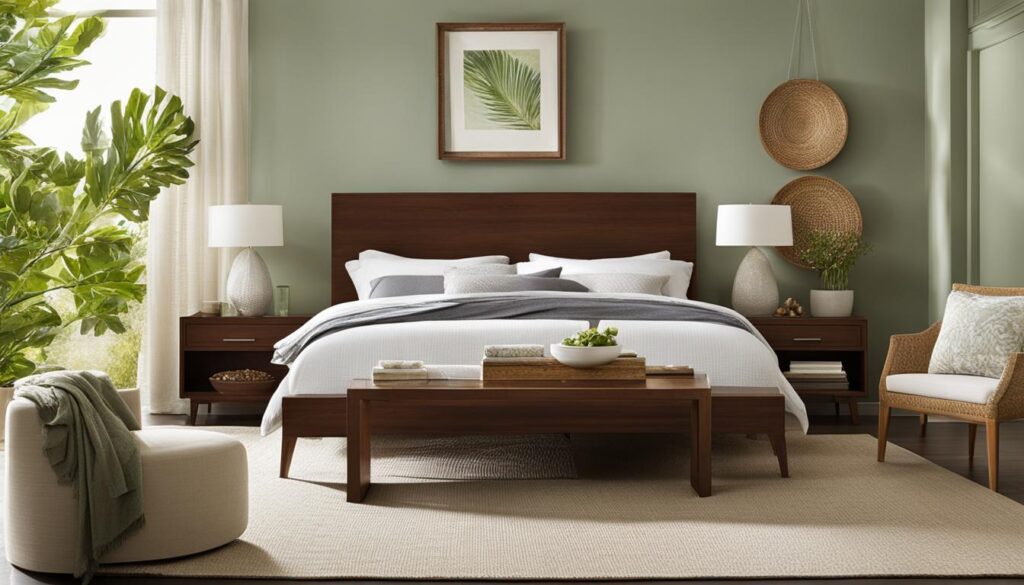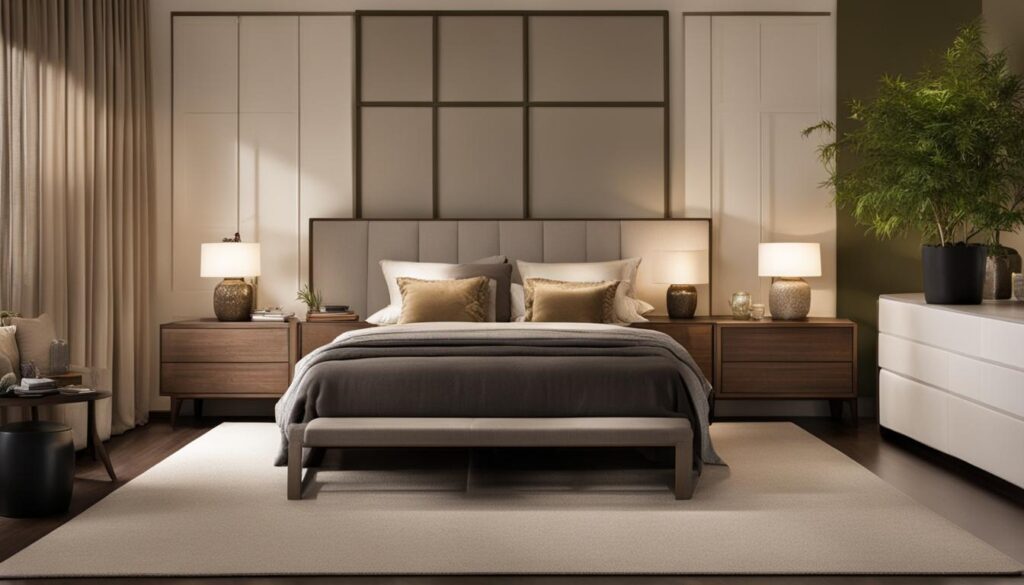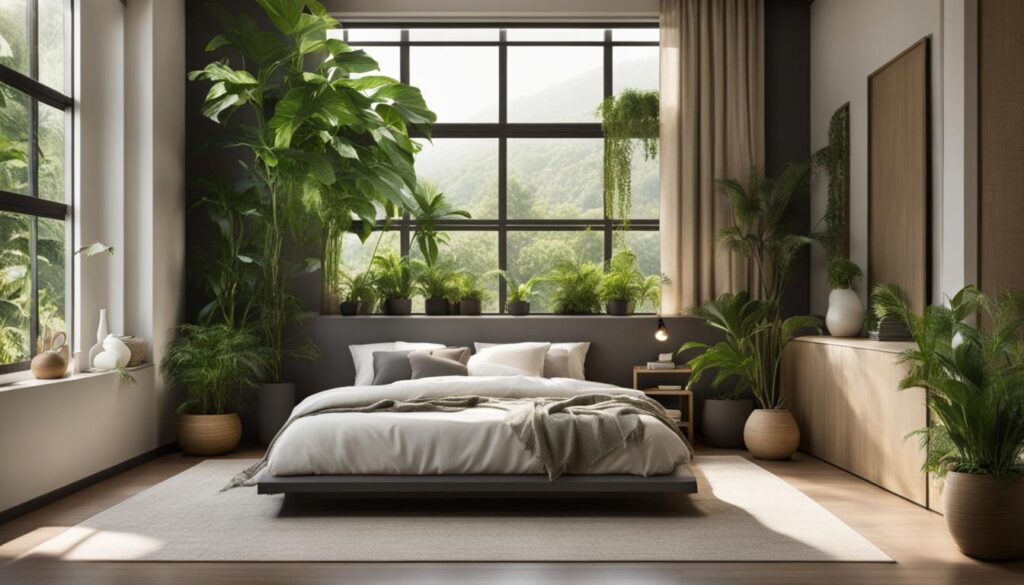Welcome to our guide on how to clean a mattress with baking soda! Your mattress plays a crucial role in ensuring a good night’s sleep, but over time it can accumulate dirt, stains, and odors. With the help of baking soda, you can easily freshen up your mattress and create a clean and healthy sleep environment. Follow our mattress cleaning tips below to learn how to effectively use baking soda to clean your mattress.
Key Takeaways:
- Regularly cleaning your mattress with baking soda helps remove odors, stains, and moisture.
- Strip the bed of sheets and bedding before cleaning and wash them in the washing machine with detergent.
- Use a vacuum or handheld vacuum to remove dirt and debris from the surface of the mattress.
- Spot clean any stains on the mattress with an upholstery cleaner or a DIY spot cleaner made with mild dish detergent.
- Sprinkle baking soda all over the mattress to absorb odors and moisture, and let it sit for 24 hours.
Vacuum Away Dirt and Debris
To effectively clean your mattress and remove dirt and debris, you’ll need to give it a thorough vacuuming. Start by using the upholstery attachment on your vacuum cleaner or a powerful handheld vacuum. This will help you reach all the nooks and crannies of your mattress and ensure a deep clean.
Begin by vacuuming the surface of the mattress, making sure to go over each area several times to remove as much dirt and dust as possible. Pay special attention to the seams, crevices, and folds in the mattress, as these areas tend to accumulate more debris. Don’t forget to vacuum the sides of the mattress as well, as they can also harbor dust and dirt.
Removing dirt and dust from your mattress:
- Use the upholstery attachment or a handheld vacuum
- Vacuum the surface, seams, and crevices of the mattress
- Don’t forget to vacuum the sides of the mattress
By thoroughly vacuuming your mattress, you’ll be able to remove dirt, dust, and allergens, creating a cleaner and healthier sleep environment.
Spot Clean Stains
To effectively remove stains from your mattress, you’ll need a reliable spot cleaner. Whether you opt for a store-bought upholstery cleaner or prefer a DIY solution, spot cleaning is an essential step in achieving a clean and fresh mattress.
If you choose to make your own spot cleaner, mix mild dish detergent with water in a spray bottle. This gentle solution is effective at tackling most protein-based stains like sweat, urine, and blood. Simply spray the spot cleaner directly onto the affected area and use a clean, damp cloth to gently dab the stain. Repeat as necessary until the stain is removed.
For tougher stains like red wine or coffee, you may need a stronger spot cleaner. There are various commercial stain removers available that are specifically designed to tackle these stubborn stains. Follow the instructions on the product packaging for best results.
Remember, it’s important to act quickly when dealing with mattress stains. The longer a stain sits, the more difficult it can be to remove. Regular spot cleaning will help keep your mattress looking and smelling its best.
Sprinkle Baking Soda on the Mattress
To freshen and deep clean your mattress, the next step is to sprinkle baking soda all over the surface. Baking soda is a natural and effective cleaning agent that helps absorb odors, moisture, and stains from the mattress. It’s a simple yet powerful solution to remove any lingering smells and leave your mattress feeling fresh and clean.
Start by sprinkling 1-3 cups of baking soda evenly across the entire mattress. Pay extra attention to areas with strong smells or visible stains. Baking soda is safe to use on all types of mattresses, including memory foam, latex, and spring mattresses. Its fine particles work their way into the fabric, allowing it to penetrate and absorb any odors or moisture trapped within.
Once you’ve sprinkled the baking soda, gently rub it into the mattress using a soft brush or your hands. This will help the baking soda penetrate deeper into the fabric and ensure that it covers the entire surface. Leave the baking soda on the mattress for at least 24 hours to allow it enough time to work its magic and absorb any unwanted elements.
Benefits of using baking soda on your mattress:
- Removes odors caused by sweat, spills, and body oils
- Absorbs moisture and prevents the growth of mold and mildew
- Neutralizes and eliminates pet odors
- Helps break down and lift stains for easier removal
- Leaves your mattress smelling fresh and clean
After the 24-hour period, it’s time to move on to the next step and get your mattress ready for a thorough cleaning.
Cleaning Your Mattress in Sunlight
Exposing your mattress to sunlight is an effective way to enhance the cleaning process and eliminate any lingering odors. Sunlight has natural antibacterial properties and helps to dry out moisture, making it an ideal step to follow after using baking soda.
When exposing your mattress to sunlight, find a location near a window that receives direct sunlight. You can also choose to move your mattress outside if weather permits. Just make sure to monitor the weather forecast to avoid any chances of rain or moisture.
Place your mattress near the window or outside for a few hours, allowing the sunlight to penetrate the fabric and kill any remaining bacteria or germs. The heat from the sun will also activate the baking soda, enhancing its odor-absorbing properties.
Benefits of Sunlight for Mattress Cleaning
- Sunlight helps to naturally eliminate odors by killing bacteria and germs.
- The heat from the sun activates baking soda, enhancing its ability to absorb moisture and odors.
- Exposing your mattress to sunlight helps to dry out any remaining moisture, preventing the growth of mold or mildew.
- It’s a cost-effective and eco-friendly method to keep your mattress clean and fresh.
Remember, sunlight is not only beneficial for your mood, but it also plays a crucial role in maintaining a clean and healthy sleep environment. After exposing your mattress to sunlight, you can proceed to the next step of vacuuming the baking soda for a thoroughly cleaned and refreshed mattress.

Vacuum the Baking Soda
After letting the baking soda sit for 24 hours, it’s time to remove it from the mattress. Use the upholstery attachment on your vacuum or a handheld vacuum to thoroughly vacuum the surface of the mattress. Remember to pay attention to the seams, crevices, and corners to ensure that all the baking soda is removed.
In addition to vacuuming the surface, make sure to run the vacuum over the entire mattress, including the sides. This will help eliminate any remaining baking soda particles and ensure that your mattress is clean and fresh.
Vacuuming the baking soda not only removes any residue, but it also helps fluff up the mattress and restore its shape. After vacuuming, take a moment to admire the clean and refreshed mattress.
Table: Steps to Vacuum the Baking Soda
| Step | Description |
|---|---|
| Step 1 | Attach the upholstery attachment to your vacuum or use a handheld vacuum. |
| Step 2 | Start from the top of the mattress and work your way down, ensuring that you cover the entire surface. |
| Step 3 | Pay special attention to the seams, crevices, and corners of the mattress. |
| Step 4 | Vacuum the sides of the mattress as well, removing any remaining baking soda. |
| Step 5 | Take a moment to appreciate the clean and fresh mattress. |
Flip and Repeat
Now that you’ve thoroughly cleaned and freshened one side of your mattress, it’s time to flip it over and repeat the process on the other side. This step ensures that both sides of the mattress receive the same level of cleaning and attention. By flipping and repeating the process, you can maintain a clean and hygienic sleep environment.
To begin, strip the bed of any bedding and flip the mattress over so that the side you just cleaned is now facing downwards. Next, sprinkle another 1-3 cups of baking soda all over the mattress, paying extra attention to areas with strong odors or stains. Allow the baking soda to sit on the mattress for another 24 hours to maximize its cleaning power.
After the 24-hour period, it’s time to vacuum the baking soda from the mattress. Use the upholstery attachment on your vacuum or a handheld vacuum to thoroughly remove all traces of baking soda. Be sure to vacuum the seams, crevices, and folds of the mattress to ensure a complete clean.
Once you’ve finished vacuuming, you can make the bed with fresh sheets and bedding on the newly cleaned side of the mattress. The other side can now be used for another night’s sleep while you follow the same cleaning process on the previously used side. This flipping and repeating method helps to evenly distribute wear and tear on the mattress, prolonging its lifespan.

Table: Summary of Flip and Repeat Process
| Step | Description |
|---|---|
| 1 | Strip the bed and flip the mattress over |
| 2 | Sprinkle 1-3 cups of baking soda on the mattress |
| 3 | Let the baking soda sit for 24 hours |
| 4 | Vacuum the baking soda from the mattress |
| 5 | Make the bed with fresh sheets and bedding |
Protect Your Clean Mattress
After investing the time and effort into cleaning your mattress with baking soda, it’s important to take steps to protect it and ensure its longevity. A mattress protector is an essential accessory that creates a barrier against spills, dirt, and other unwanted elements. By using a mattress protector, you can keep your mattress fresh, clean, and free from potential damage.
A mattress protector acts as a shield, guarding your mattress from liquid stains, allergens, and dust mites. It is designed to be breathable, allowing air to flow freely while effectively protecting your mattress. The protector creates a healthy sleeping environment by preventing the buildup of bacteria and dust, which can lead to allergies and respiratory issues.
When choosing a mattress protector, opt for one that is waterproof and hypoallergenic for full protection. Look for features like a secure fit, easy installation, and machine washable materials for hassle-free maintenance. Investing in a high-quality mattress protector not only safeguards your mattress but also enhances your sleep experience by providing an additional layer of comfort and softness.
In addition to using a mattress protector, it’s also important to follow a regular cleaning schedule to maintain the cleanliness of your mattress. By cleaning your mattress with baking soda 1-2 times a year and using a mattress protector, you can ensure that your mattress remains fresh, odor-free, and in excellent condition for years to come.
| Benefits | Protection | Comfort | Hygiene |
|---|---|---|---|
| Prevents liquid stains | ✔ | ✔ | ✔ |
| Blocks allergens and dust mites | ✔ | ✔ | ✔ |
| Breathable fabric | ✔ | ✔ | ✔ |
| Easy to install and remove | ✔ | ✔ | ✔ |
| Machine washable | ✔ | ✔ | ✔ |
Using a mattress protector not only safeguards your investment but also enhances your sleep experience. It keeps your mattress fresh, clean, and free from potential damage, ensuring a healthier and more comfortable sleep environment.
Cleaning Schedule
Keeping your mattress clean is essential for a good night’s sleep and overall hygiene. Establishing a regular cleaning schedule will help you maintain a fresh and odor-free sleeping surface. By following these guidelines, you can ensure that your mattress stays in top condition for years to come.
Frequency
It is recommended to clean your mattress with baking soda at least once every six months. This frequency allows you to remove dirt, allergens, and odors that accumulate over time. Additionally, if you suffer from allergies or have pets, you may want to consider cleaning your mattress more often, such as every three months, to prevent allergen buildup.
Spring and Fall Cleaning
As the seasons change, it’s a good time to give your mattress a deep clean. Use the baking soda cleaning method outlined in this article during the spring and fall to refresh your mattress. By doing so, you can eliminate any accumulated odors or stains that may have developed over the previous months.
Pro Tip: If you have young children or pets that frequent your bed, spot cleaning may be necessary more frequently. Accidents happen, but by promptly addressing stains and spills, you can prevent them from becoming permanent.
Additional Considerations
In addition to regular cleaning, it’s important to maintain good mattress hygiene. Here are a few tips to keep in mind:
- Use a mattress protector to safeguard against spills, stains, and dust mites.
- Rotate your mattress every three to six months to distribute wear and tear evenly.
- Vacuum your mattress regularly to remove surface dirt and allergens.
By implementing a cleaning schedule and following these additional steps, you can ensure that your mattress remains clean, fresh, and comfortable for years to come.
Conclusion
Cleaning your mattress with baking soda is a simple and effective way to achieve a deep clean. The homemade mattress cleaner, made of baking soda, helps eliminate odors, stains, and moisture, ensuring your mattress stays fresh and odor-free.
Regular maintenance and cleaning using baking soda can extend the lifespan of your mattress and provide a comfortable and healthy sleep environment. By following the step-by-step guide outlined in this article, you can easily deep clean your mattress and enjoy a rejuvenated sleeping surface.
Remember, incorporating a cleaning schedule that suits your needs and makes use of the homemade mattress cleaner can help keep your mattress in its best condition. With a little effort and the power of baking soda, you can enjoy a clean, fresh, and revitalized mattress for years to come.
FAQ
How often should I clean my mattress with baking soda?
It is recommended to clean your mattress with baking soda 1-2 times a year to keep it fresh and odor-free.
Can I use baking powder instead of baking soda to clean my mattress?
No, baking powder and baking soda are not the same. Baking soda is specifically designed for cleaning and deodorizing purposes.
How long should I leave the baking soda on the mattress?
It is best to leave the baking soda on the mattress for 24 hours to allow it to absorb odors and moisture.
Can I use a regular vacuum cleaner to remove the baking soda?
Yes, you can use a regular vacuum cleaner with the upholstery attachment or a handheld vacuum to remove the baking soda from the mattress.
Do I need to vacuum both sides of the mattress?
Yes, it is recommended to flip the mattress over and repeat the process on the other side to ensure both sides are thoroughly cleaned and freshened.
How does sunlight help in the cleaning process?
Sunlight can activate the baking soda and speed up the cleaning process. It helps to place the mattress next to a window or outside in direct sunlight, if possible.
How do I protect my clean mattress?
You can use a mattress protector to create a barrier against spills, dirt, and other unwanted elements. This makes future cleaning easier and helps extend the life of your mattress.
Can I use a different spot cleaner for tough stains?
Yes, if the regular spot cleaner doesn’t remove tough stains like red wine or coffee, you may need a stronger spot cleaner specifically designed for those types of stains.
Can I skip the spot cleaner and just use baking soda to clean stains?
While baking soda is great for absorbing odors and moisture, it may not be as effective in removing tough stains. It is recommended to use a spot cleaner for best results.
Can I use this method to clean a memory foam mattress?
Yes, you can use baking soda to clean a memory foam mattress. Just make sure to be gentle when vacuuming and avoid using excess moisture.

